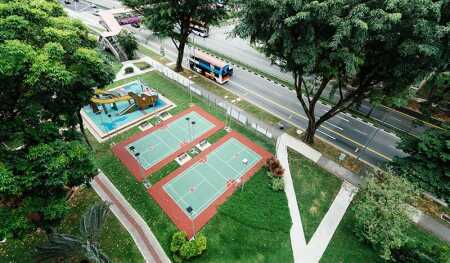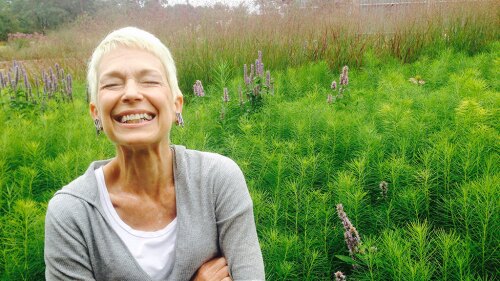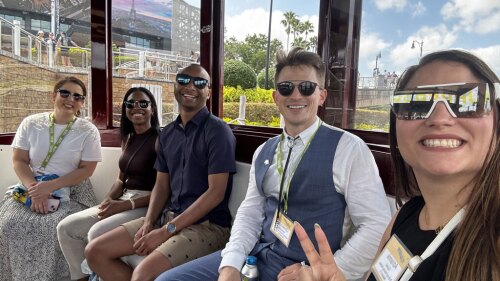The ULI Health Leaders Network is empowering real estate and land use professionals with the skills, knowledge, and networks to improve health outcomes in their professional practice and communities. The 32 Health Leaders who were selected for Cohort 1, which ran from October 2017 to June 2018, undertook a series of activities, including in-person gatherings, learning-focused webinars with leaders in the health and built-environment field, small group work, and individual assignments.
Members of the ULI Health Leaders Network were asked to reflect on when they first grasped that the built environment and the design of communities play a significant role in the ability to make healthy choices and live healthy lives. This group of professionals—which includes architects, real estate experts, urban planners, health experts, and community developers—presented a range of these “a-ha moments”: some realized it early in life while others made connections later through their professional experiences. Regardless of how or when, however, each Health Leader is committed to improving public health through the work that he or she does to improve buildings, communities, and cities.
Read some of their a-ha moments below, and let us know by emailing us at [email protected]: When did you first recognize the connections and how are you working to improve public health?
An architect, urban planner, and engineering consultant make connections through personal childhood and young adult experiences:
Bethany Madsen, architect and project manager at VIA Architecture in Seattle, Washington:
“In the early 2000s, [I was trying to live a healthier life and] therefore looked for ways to incorporate movement into my daily routine. At the time, I was living about 1.5 miles [2.4 km] from my office and I started to walk to work. I timed the difference between taking a bus [including wait time] and walking and found that the bus was 30 minutes, the walk took 35. This was also when I realized how pleasant it was to start and end the day with a brisk walk, not to mention how inefficient that particular bus line was.”
Stephen Gyor, lead sustainability planner at the D.C. Office of Planning, Washington, D.C.:
“I was raised in Mayfield Heights, Ohio, which is about 10 miles [16 km] outside of Cleveland. Mayfield Heights is a typical sprawling 1950s suburb in that it was designed primarily for the automobile. Mayfield’s main arterial, Mayfield Road, is eight lanes wide, lined with strip malls, and includes a multitude of curb cuts. As a result, walking in Mayfield Heights is often not a pleasant experience. Obesity and chronic disease are rampant in Mayfield and other nearby communities. Although I was generally aware of the car-oriented nature of the area and its relatively high obesity rates, I did not fully appreciate the connection between chronic disease and communities where walkability is a low priority.
During college I moved to Washington, D.C., where I regularly walked to class, work, and the grocery store. For the first time, I used public transit on a regular basis. I noticed that the city’s dense network of streets, ground-floor retail, and tree canopy encouraged pedestrian activity. Furthermore, D.C.’s well-designed public spaces seemed to encourage exercise and other outdoor activities, leading to increased social cohesion and sense of place. I noticed that I felt better, both mentally and physically, than I ever had before. I thought there must be some intersection between the city’s form and my personal wellness. Perhaps this was true for the population as well? This was my first ‘a-ha’ moment.”
Eddie Arslanian, principal at Ramboll Environ in Los Angeles, California:
“I first realized the impact on human health from the built environment when my family and I moved to the suburban community of Westminster in southern California from Beirut, Lebanon, in 1986 due to the civil war. The transition on our family of moving from a city metropolis to a suburban atmosphere was felt immediately and was profound. To be more specific, the layout of the endless suburban feel as opposed to the dense and cozy feel of our prior city life had a significant impact on the mental well-being of our family, especially our grandparents who had moved in with us.
In our suburb of Westminster, California, we had a nice single-family house with a yard and a swimming pool. On the surface, this was very satisfying because it was definitely a larger and nicer home than our apartment unit in Beirut. However, given the spread-out feel of the suburbs, there was less of a sense of community. There was a more formal social network in the suburbs and the opportunities for interaction were far and few. This had the most profound impact on the well-being of my grandparents. [In Beirut], they used to have an active social life in the community participating in nonprofit activities whereas they would attend meetings by walking. Now, they were stuck at home watching TV most of the time unless they used the car to go somewhere. In the suburbs, walking was performed as a necessary separate form of exercise and not part of the daily active lifestyle.”
Two architects, a real estate developer, and a placemaking consultant learn through professional experiences:
Kris Callori, principal at Verdacity LLC in Albuquerque, New Mexico:
“Coincidentally, while I was preparing for the WELL exam, I was also designing a new office space for my growing company. Considerations such as sit/stand desks and water purification systems began to rise above what I had believed to be the typical aspects of building performance [energy savings, daylight autonomy, etc]. As I learned more about how the design of spaces affected human health, I realized that these qualitative aspects would reward me and my employees beyond what I would normally have expected from the built environment. The space around me began to contribute in a different way.”
Marja Williams, development manager and real estate developer with Oranje LLC on Bainbridge Island, Washington:
“My work on the Grow Community project on Bainbridge Island [in Washington state] led to my interest in the connections between health and the built environment. Our process began in 2009 when a group of local, social-impact investors asked my team to create the most sustainable project ever built. While our original focus was on creating net-zero homes, we quickly learned through a series of community focus groups that what buyers were truly interested in was the opportunity to live in a place designed to increase their overall health and well-being.
The result is a new pattern of development, nesting a series of pocket neighborhoods together to form one midsized community of 43 homes. Paths lead from the parking areas, through community gardens to front porches of each home. Automobiles do not cross pathways, making the neighborhood safe for young children to run, bike, and play throughout the neighborhood. Shared green spaces are activated and located throughout the neighborhood. Everything is intentionally designed to allow for unintentional interactions. Neighbors pass each other on the way to school or to the store. They stop to chat with each other in the garden or while walking a dog. Connections are made and friendships are formed. Social capital grows as long-term relationships develop.” Now that the project has been occupied for over four years, it is interesting to see how the design of the built environment can have an immense impact on social and emotional well-being of residents.”
Patricia Cornelison, principal at Arrowstreet in Boston, Massachusetts:
“I was lucky enough to be part of a team that worked on the Healthy Base Initiative [HBI], a project for the Department of Defense that explored a number of pilot studies aimed at making military installations healthier places to live, work, learn, and play. The emphasis was on reducing the incidence of obesity and tobacco use, which are problems as big in the military as they are in the general population. The background research I did for this project provided a much deeper understanding of the subject matter. Through the project, I also came into contact with public health professionals at the Army Public Health Command and we worked together to develop a tool for measuring how well the physical environment of an installation promotes and enables a healthy lifestyle. They learned about community planning and I learned about public health.”
Stephanie Echeveste, art and retail curator at Distill Creative in New York, New York:
“When l started a job in real estate—commercial and retail real estate—my understanding of the impact of the built environment on health began to evolve. I realized the power of landowners and the government that regulates the land. I became hyper-aware of how people use space and how certain areas are valued not just in price, but by use and desire from the public.
Now, every time I go back to my hometown in the suburbs outside Phoenix, Arizona, I get really frustrated. Not only do I lose a massive amount of physical exercise from my normal day-to-day because I am not walking around from point A to point B, but I miss out on those nice moments when I might linger at a corner or stop into a store I hadn’t previously noticed or run into a friend whom I hadn’t seen in a while. I notice how much my urban, walkable environment also impacts my mental health and social needs. I also realize how easy it is to default to using a car when it is an option, even if places are well within walking distance.”
A physician advocates for a healthier commercial corridor due to neighborhood concerns:
Stuart Levin, physician with Wake Internal Medical Consultants in Raleigh, North Carolina:
I became interested in the literature on [health and land use] topics while serving as chair of a group of stakeholders in the Blue Ridge Corridor [BRC] that is focused on coordinating the area’s rapid growth. In my office, I was seeing firsthand the rise in obesity and associated diseases such as diabetes over the past two decades and noted that minimal attention was being paid to the root causes of obesity within the medical literature. Ultimately, my professional interests began to overlap with my role in the BRC planning process.”





